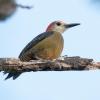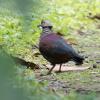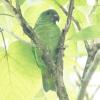Day 1 - We will be met by our driver and our guide in Montego Bay this morning and we will make our way to the famous Rocklands Bird Sanctuary, about 45 minutes away. At Rocklands Sanctuary, we will have the unique opportunity to feed two species of endemic hummingbirds, right from our hands, the Red-billed Streamertail and the Jamaican Mango. Other birds we could encounter here include Sad Flycatcher, Orangequit, Yellow-faced and Black-faced grassquits, Jamaican Oriole, Jamaican Woodpecker and much more. A stop at the Bogue Lagoons today could yield a variety of waterbirds, including West Indian Whistling-Duck, Common Gallinule, Black-necked Stilt, Least Grebe, Tricolored Heron, and Snowy Egret to name a few species. Night at Montego Bay.
Day 2 - Today is mostly a travel day, as we make our way from Montego Bay to Port Antonio, on the eastern side of the island, a journey of about 5 hours, not including stops. We will stop for lunch, as well as a couple of birding sites, including salt pans were we could see wading birds and shorebirds, such as Reddish Egret, White Ibis, Little Blue Heron and more. Over the Caribbean, we will see Brown Pelicans, Magnificent Frigatebirds and Royal Terns, as well as Ruddy Turnstones along the shore. Once in Port Antonio, we will check into our accommodations and have dinner, after which time we may venture out to look for the endemic Jamaican Owl. Night at Port Antonio.
Day 3, 4, 5 - For the next three days we will use Port Antonio as our base to explore the Blue and John Crow Mountains, an area rich in endemic birds. These forests are home to the rare and declining Jamaican Blackbird, as well as Black-billed and Yellow-billed parrots, Ring-tailed Pigeon, White-eyed Thrush, White-chinned Thrush, Blue Mountain Vireo, Yellow-shouldered Grassquit, and Jamaican Euphonias. With a little luck, we'll spot the elusive Crested Quail Dove on the road or at the edge of a path along our travels. At the eastern end of the island, we hope to see the third endemic species of hummingbird, the Black-billed Streamertail, as well as the Vervain Hummingbird, the second smallest hummingbird in the world, after Cuba's Bee Hummingbird. Not only is Jamaica full of endemic birds, but there are also many North American species that spend their winter here, such as Cape May and Black-throated Blue warblers, Worm-eating Warbler, American Redstart, and Common Yellowthroat to name a few species. One morning we will look for White-tailed Tropicbirds as they fly over the sea near the nesting cliffs. Nights in Port Antonio.
Day 6 - After a little morning birding at Goblin Hill / Fairy Hill, we will start our journey back to Montego Bay. The tour will end in Montego Bay this afternoon.





